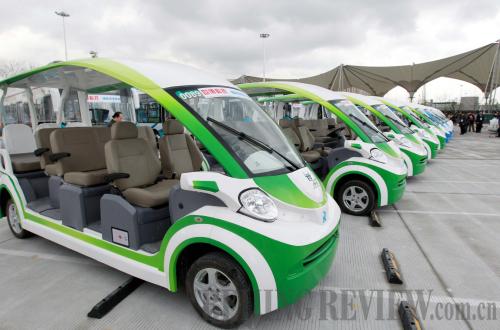|
 |
|
LYING IN WAIT: Environmentally-friendly cars ready for a big future(XINHUA) |
To some extent, what the new energy car is going through in China is similar to last year's Oscar-winning film, The Hurt Locker. They were both created with a noble purpose in mind, but received disappointing results at the box office. The customers didn't jump on board.
The best proof of this is the market performance of hybrid cars, the early front-runner among new energy cars.
Generally powered by a gas engine and an electric motor, the hybrid car is estimated to be 30 percent more fuel efficient than a regular car. However, annual sales of hybrid car in China totaled a mere 2,000 units. Even China's most successful hybrid car, the well-known Toyota Prius (manufactured by TFTM, a Sino-Japanese joint venture based in Tianjin) only sold some 4,000 units in the past four years.
Yang Jianming, a company clerk in Beijing who is planning to buy his first car, said he would not consider hybrid vehicle, despite its environment-friendly and energy-efficient reputation.
"Buying a hybrid car is just so impractical for me," he told ChinAfrica.
Yang said what he needs is simply a tool of transport so that he can cut out his daily 4-hour bus and subway trips commuting to and from work. He also said he prefers a fuel-saving car, but even a typical hybrid with a 1.5-liter engine would cost more than 200,000 yuan, which is "far more expensive" than his budget of 100,000-150,000 yuan.
Furthermore, the cost difference between a hybrid car and a regular car is unlikely to be recouped during its normal service life.
This price difference is clearly shown by another popular hybrid model, the Honda Civic. In China, a Civic hybrid costs about 260,000 yuan, while a regular Civic costs 100,000 yuan less. If an ordinary family car travels 1,500 km per month and consumes 120 liters of fuel, the monthly fuel cost for a regular Civic will be about 700 yuan.
"Even if the hybrid car can save half the fuel of a regular one, it still takes nearly 25 years for me to earn back my extra spending of 100,000 yuan," estimated Yang, based on the amount driving he expects to do.
The buyer's logic is quite clear: hybrid cars may be fuel-efficient, only not enough to make up the price difference.
Cool market, burning ambition
Then there is the next member of the new energy car family, the electric vehicle (EV). But is it any more popular in China?
In fact, China, like the rest of the world, does not even have a real EV market, since few automakers have generated mass production.
At the end of 2008, Chinese automaker BYD released the F3DM, an EV model, which can run either in pure electric power mode or hybrid power mode. As the world's first commercialized EV model, however, the F3DM has only sold some 100 units so far and all buyers claimed collective purchasing, rather than individual, private buyers.
According to a research on China's new energy car market published in April by Sinotrust, a leading consultancy service provider, only 26.6 percent of 1,174 respondents chose an EV when asked the question: "What kind of new energy car do you prefer?" However, 61.4 percent showed interest in hybrid cars. (Graph 1)
Compared with the hybrid car, it seems the EV faces a more difficult marketing challenge.
But despite the cold market, automakers in China show great enthusiasm towards new energy vehicles, especially EVs.
According to a China Business News report, in 2009 alone, there were more than 20 automakers in China who announced that they had successfully developed a pure electric car model. That number is even higher than that in Japan, the first country to begin developing EVs.
Meanwhile, on the list of Recommended Models of the Energy-Saving and New Energy Vehicle Demonstration Projects, published on the website of the Ministry of Industry and Information Technology, almost all the major domestic automakers have listed their green car models, of which there are now more than 100.
Since early 2009, in order to promote the new energy automotive industry in China, the Chinese Government has issued a number of relevant policies, including promoting EV production and sales by increasing the existing production capacity, experimenting with energy-saving and new energy vehicle policy-trial-runs in medium and large cities, and providing financial subsidies for R&D groups and institutions involved in new-energy auto promotion and demonstration. Market observers believe that the industrialization of China's EV sector has seen "remarkable acceleration" thanks to these favorable policies. But the question is, will the EV stick around for the long run, or will it be a passing fad?
|